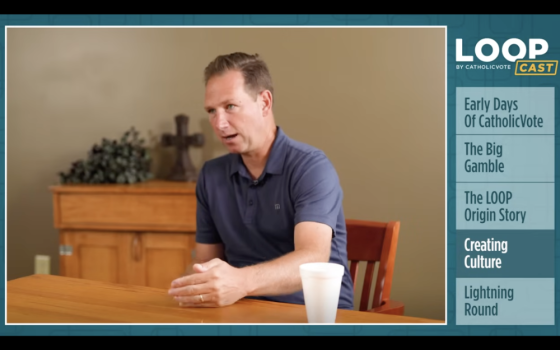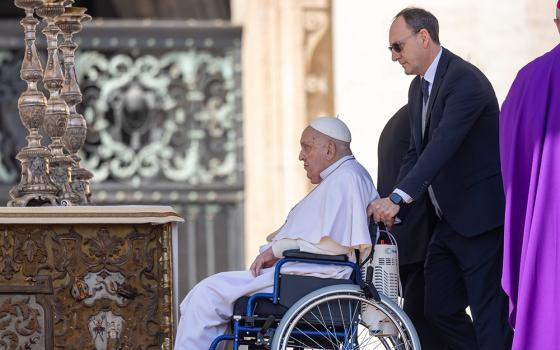Pope Francis appears on the central balcony of St. Peter’s Basilica to deliver his Easter blessing "urbi et orbi" (to the city and the world) at the Vatican April 20. Archbishop Diego Ravelli, master of ceremonies, is at right. Francis' Easter appearance would be his final public event; he died the next morning. (CNS/Pablo Esparza)
When Pope Francis appeared on the loggia of St. Peter's Basilica a few minutes after noon Roman time on Easter Sunday, the crowds roared.
The 88-year-old pontiff who for the last 12 years thrilled the masses had not disappointed: Despite bowing out of all official Holy Week liturgies following his five-week hospitalization for double pneumonia, the pope of the people was with his flock and would carry on the tradition of offering his Easter blessing.
For weeks, the Vatican had refused to speculate about the pope's Holy Week plans. But the pope, who from the early days of his pontificate had earned a reputation as a maverick who set his own agenda, had been busy.
Despite a doctor-mandated two-month convalescence at his Vatican home, Francis made his first surprise appearance in St. Peter's Square on April 6 at a special Mass for health care workers and the sick.
His voice was gravely and he only spoke a few words, but he appeared more healthy than when he was discharged from the hospital on March 23 and returned to the Vatican.
A few days after he left the hospital, Francis held an unannounced private meeting with Britain's King Charles III and Queen Camilla. He then began showing up in St. Peter's Basilica to pray and greet tourists so often that it seemed a stretch to label these visits a surprise — they had become routine.
The pope's chief surgeon had told reporters that after assessing Francis' impressive recovery, he thought he would return to 90-100% of his pre-hospitalization condition.
But his recent appearances showed signs that a different pope had returned to the Vatican than the one who had left it when he was hospitalized on Feb. 14. Perhaps only hindsight provides the clarity to clearly assess the changes.
Pope Francis greets inmates during a Holy Thursday visit to Rome's Regina Coeli jail April 17. (CNS/Vatican Media)
For a pope who often spoke more through gestures than with words, the same impulse to be close to people and to be a pastor first and foremost, still motivated him.
After visiting prisoners at Rome's Regina Coeli prison on Holy Thursday, he joked with reporters about his health, saying that he was doing "as best I can." Even though he could not wash the feet of the prisoners, as was his Holy Thursday tradition, he had made the point that he did not want the church — or the world — to forget people on the margins.
He gave similar attention to the overlooked ones, or what the Gospels call "the least of these" in visits to St. Peter's Basilica to pray or during his Easter Sunday ride in the popemobile around St. Peter's Square — his first post-hospitalization. He had his driver stop the vehicle so he could bless small children and pass out candy.
But from a bird's-eye view of his appearance on the balcony of St. Peter's Basilica, it was clear to most reporters that the pope who arrived via wheelchair to bless the masses had an almost dazed look in his eyes.
His voice was still weak — that was to be expected — but he engaged less than usual with the pilgrims below. He looked ahead, seemingly determined to get through the blessing, and only that.
Many vaticanisti were shocked as we saw him later arrive in St. Peter’s Square in the popemobile. At one point, an assistant appeared to massage his back, the pain on Francis' face obvious. During the ride, he made fewer direct encounters with individuals in the crowd. At times, the pope looked disoriented. Still, he pressed on.
On Easter Sunday evening, a senior Vatican official, who asked not to be named, said that the pope has had some good days and bad days since returning home from the hospital. He described Easter Sunday as one of the bad days, but also said that plans for the pope to travel to Turkey later this year were still in the works. It likely would not be in May, the original plan, but at some point over the summer so the pope could mark the 1700th anniversary of the Council of Nicaea.
At 9:45 a.m. Monday (April 21), the Vatican's press office sent a Telegram message saying that there would soon be a brief transmission from the chapel of the Casa Santa Marta, the Vatican guest house where Francis resided.
Could this be the long-rumored resignation? Unlikely, given the timing — Easter Monday (Pasquetta) — an Italian national holiday. That didn't seem to add up. The worst fears of many were clear when the brief streaming video began. The grim faces of the four prelates tasked with sharing the news of the pope's death told the story.
Shortly thereafter, at the Vatican, some groups of pilgrims seemed blissfully unaware of what awaited them when they arrived. But others — sobbing on the Roman streets — had just heard the news.
Pope Francis greets a child from the popemobile after giving his Easter blessing to thousands of people in St. Peter's Square at the Vatican April 20. (CNS/Vatican Media)
The Italian daily, Corriere della Sera, has reported that the pope woke about 6 a.m. Monday and seemed well until about 7 a.m. local time.
On Monday evening, the Vatican said that the pope had experienced a cerebral stroke about 7 a.m. He then fell into a coma and died about a half hour later.
Many commentators have been quick to point out that Francis' death on Easter Monday, when Catholics are celebrating the resurrection of Christ and the promise of eternal life, is a fitting and beautiful end for a pope who was always quick to emphasize the Christian message of hope.
But in paying tribute to a churchman who was just keen to elevate the plight of those who are marginalized and suffering, we should also remember that Easter only comes after the Way of the Cross and the long walk to Calvary.
And in his final days, through spending more time with prisoners than the politicians who came to visit him at the Vatican, Francis managed to live that via crucis for the world to see one final time.
The National Catholic Reporter's Rome Bureau is made possible in part by the generosity of Joan and Bob McGrath.
Advertisement





